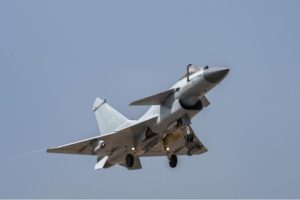
Russian-Finnish Tensions Rise Amidst Border Closures and “Hybrid” Tactics
By Lionel Beehner

Russian border crossing at Paljakka, Kuusamo, Finland. In light of rising tensions, Finland shut down its border with Russia.
“There are hundreds and possibly thousands of people close to Finland’s border on the Russian side that could be instrumentalized against Finland.”
In December 2023, Finland closed its 800-mile border with Russia, which included three maritime crossings for smaller boats, in the wake of Finland formally joining NATO. These closures have heightened tensions between Russia and Finland.
According to the first article from the Norway-based The Barents Observer, the closure includes three maritime border crossings for smaller boats, which will impact leisure boating in the Barents Sea. As per a second article, also from The Barents Observer, Finland had been overwhelmed with over a thousand migrants and asylum seekers from the Middle East and Africa. According to the article, Moscow has orchestrated the influx of migrants in a deliberate “hybrid” tactic by the Russian government – so-called “instrumentalized immigration” – to overwhelm the country and its border police as a punishment for closing the border to Russians. Authorities in Moscow have organized flows of asylum seekers on Finland’s eastern border since last fall, the Finish prime minister has argued. A representative for the Finnish border guard said that the maritime border was important to close because reaching Finland by sea is “life threatening,” given the Baltic Sea’s much harsher conditions than the Mediterranean.[i]
In response, the European Union has voiced its support for Finland. The president of the European Commission, Ursula von der Leyen, paid a visit to the Finnish-Russian border in April to say that “Europe stands by your side” as it seeks to secure its border against such “hybrid attacks.”[ii] With the weather warming up, officials there expect an even larger influx of migrants and asylum seekers in the weeks and months ahead. For the latter half of the 20th century, following a war between the Soviet Union and Finland in 1939, relations between the two neighbors were relatively peaceful. The recent rise in tensions and border closures have drawn concerns that Russia, beyond staging hybrid operations like “instrumentalized immigration,” could stage a false-flag border intervention to test NATO resolve and its Article Five protections.
OE Insight Summary:
As the RUS-FIN border remains indefinitely closed, RUS has employed hybrid tactics and ‘instrumentalized immigration’ to protest FIN joining NATO.
Sources:
“Finland’s eastern border to remain shut indefinitely (Восточная граница Финляндии останется закрытой на неопределенный срок),” The Barents Observer (independent Norwegian news site in Russian and English currently blocked in Russia), 8 April 2024. https://thebarentsobserver.com/ru/granicy/2024/04/vostochnaya-granica-finlyandii-ostanetsya-zakrytoy-na-neopredelennyy-srok
In the past, the closure has been reconsidered every couple of months, but this time the decision is open-ended…
With warmer weather on the way, this time the decision also covers border crossing points at three small-boat harbours: Haapasaari, an island off the southeastern city of Kotka, Santio, an island in Virolahti, Finland’s southeasternmost municipality, and Nuijamaa lake harbour in Lappeenranta on the Russian border. They will be closed to pleasure boat traffic from mid-April. “By closing border crossing points for maritime traffic to leisure boating, the Government is preparing for the possibility that instrumentalised migration could expand to maritime traffic as spring progresses,” the Interior Ministry said in a statement.
“This would be dangerous to people seeking to enter Finland and would burden maritime search and rescue,” it went on to say.
The frontier has been closed since December, when Finnish authorities accused Russia of orchestrating the flow of third-country asylum seekers across the border as a means of hybrid influence.
Nearly two months ago, the government led by Prime Minister Petteri Orpo (NCP) extended the closure until 14 April. Another extension was widely expected, with officials predicting that favourable spring weather conditions would spur more arrivals across the border.
The cabinet also plans to ask Parliament soon to approve a more stringent border law that would allow migrants deemed to have no grounds for seeking asylum to be immediately sent back to Russia. That bill, which was still being finalised on Thursday, has come under criticism for violating international border treaties.
Atle Staalesen, “As Helsinki prepares new measures against Russian hybrid operations, President Stubb makes visit to the border,” The Barents Observer (independent Norwegian news site in Russian and English currently blocked in Russia), 27 March 2024. https://thebarentsobserver.com/en/borders/2024/03/helsinki-prepares-new-measures-against-russian-hybrid-operations-president-stubb
Together with his wife, President Alexander Stubb on Wednesday arrived at Niirala checkpoint where he met with representatives of the Finnish Border Guard. Captain of the border guard station Mikko Sorasalmi gave the president an introduction to equipment applied by the border patrols. On site were also representatives of the EU border agency Frontex and the discussion took place in Finnish, English and German, Yle reports.
The Niirala border-crossing point used to be site buzzing with travellers, but since mid-December the border between Finland and Russia has been closed and travellers forced to use checkpoints in the Baltic states or northern Norway. The closure came after several thousands of migrants flocked from Russia and into the Schengen zone through the Finnish border-crossing points. Finnish authorities are confident that the migrant flows were orchestrated by Moscow as part of a hybrid influence operation.
This week’s visit of Alexander Stubb comes as Finland is preparing new measures to counter Russian hybrid influence on the country. Last week, the government completed a draft law that is aimed at preventing asylum seekers from entering the country. The bill aims at preventing asylum seekers from entering the country. The acceptance of asylum applications would be significantly limited. The bill is balancing between national security concerns and international human rights consideration, representatives of the government admit … It is aimed at influencing Finland’s national security and public order, the government leader underlines. “We have to prepare for the fact that the situation may get more difficult when spring arrives,” he said in last Friday’s press conference. “The authorities need tools to manage the terrain border.”
Notes:
[i] Mariia Yemets, “Finland closes sea checkpoints near border with Russia until mid-April,” Ukrainska Pravda, 5 April 2024. https://www.pravda.com.ua/eng/news/2024/04/5/7449951/
[ii] Doug Cunningham, “Ursula von der Leyen visits border to stand by Finland against Russian ‘hybrid attacks’,” UPI, 19 April 2024. https://www.upi.com/Top_News/World-News/2024/04/19/Finland-EU-Russian-hybrid-attacks/1921713541719/
Image Information:
Image: Russian border crossing at Paljakka, Kuusamo, Finland. In light of rising tensions, Finland shut down its border with Russia.
Source: Fanny Schertzer, (https://commons.wikimedia.org/wiki/Category:Finland-Russia_border#/media/File:Finnish-Russian_border,_Paljakka-2.jpg)
Attribution: CC BY-SA 3.0
Distribution A: Approved for public release
Categories:
Tags:
Related Products
Chinese Military Exercises Highlight Improvements in Joint Operations






